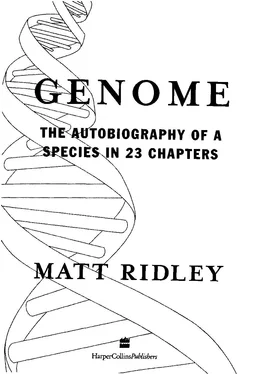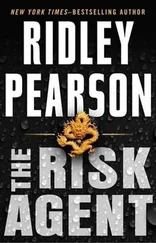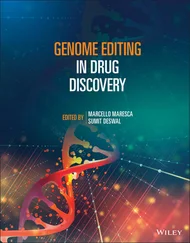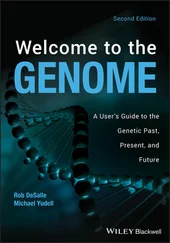Genome - Matt Ridley
Здесь есть возможность читать онлайн «Genome - Matt Ridley» — ознакомительный отрывок электронной книги совершенно бесплатно, а после прочтения отрывка купить полную версию. В некоторых случаях можно слушать аудио, скачать через торрент в формате fb2 и присутствует краткое содержание. Жанр: Старинная литература, на английском языке. Описание произведения, (предисловие) а так же отзывы посетителей доступны на портале библиотеки ЛибКат.
- Название:Matt Ridley
- Автор:
- Жанр:
- Год:неизвестен
- ISBN:нет данных
- Рейтинг книги:5 / 5. Голосов: 1
-
Избранное:Добавить в избранное
- Отзывы:
-
Ваша оценка:
- 100
- 1
- 2
- 3
- 4
- 5
Matt Ridley: краткое содержание, описание и аннотация
Предлагаем к чтению аннотацию, описание, краткое содержание или предисловие (зависит от того, что написал сам автор книги «Matt Ridley»). Если вы не нашли необходимую информацию о книге — напишите в комментариях, мы постараемся отыскать её.
Matt Ridley — читать онлайн ознакомительный отрывок
Ниже представлен текст книги, разбитый по страницам. Система сохранения места последней прочитанной страницы, позволяет с удобством читать онлайн бесплатно книгу «Matt Ridley», без необходимости каждый раз заново искать на чём Вы остановились. Поставьте закладку, и сможете в любой момент перейти на страницу, на которой закончили чтение.
Интервал:
Закладка:
1 9 2 G E N O M E
Although no such easy explanation yet exists for the mutation on chromosome 13 that predisposes Ashkenazis to develop breast cancer, it is quite possible that many racial and ethnic genetic peculiarities do indeed have a reason for their existence. In other words, the genetic geography of the world has a functional as well as a mapping contribution to make to the piecing together of history and pre-history.
Take two striking examples: alcohol and milk. The ability to digest large amounts of alcohol depends to some extent on the overproduc-tion by a certain set of genes on chromosome 4 of enzymes called alcohol dehydrogenases. Most people do have the capacity to pump up production by these genes, a biochemical trick they perhaps evolved the hard way — that is, by the death and disabling of those without it. It was a good trick to learn, because fermented liquids are relatively clean and sterile. They do not carry germs. The devastation wrought by various forms of dysentery in the first millennia of settled agricultural living must have been terrible. 'Don't drink the water', we westerners tell each other when heading for the tropics.
Before bottled water, the only supply of safe drinking water was in boiled or fermented form. As late as the eighteenth century in Europe, the rich drank nothing but wine, beer, coffee and tea. They risked death otherwise. (The habit dies hard.) But foraging, nomadic people not only could not grow the crops to ferment; they did not need the sterile liquid. They lived at low densities and natural water supplies were safe enough. So it is little wonder that the natives of Australia and North America were and are especially vulnerable to alcoholism and that many cannot now
'hold their drink'.
A similar story is taught by a gene on chromosome 1, the gene for lactase. This enzyme is necessary for the digestion of lactose, a sugar abundant in milk. We are all born with this gene switched on in our digestive system, but in most mammals - and therefore in most people — it switches off during infancy. This makes sense: milk is something you drink in infancy and it is a waste of energy making the enzyme after that. But some few thousand years ago, human P R E - H I S T O R Y 1 9 3
beings hit on the underhand trick of stealing the milk from domestic animals for themselves, and so was born the dairy tradition. This was fine for the infants, but for adults, the milk proved difficult to digest in the absence of lactase. One way round the problem is to let bacteria digest the lactose and turn the milk into cheese. Cheese, being low in lactose, is easily digestible for adults and children.
Occasionally, however, the control gene which switches off the lactase gene must suffer a mutation and the lactase production fails to cease at the end of infancy. This mutation allows its carrier to drink and digest milk all through life. Fortunately for the makers of Corn Flakes and Weetabix, most western people have acquired the mutation. More than seventy per cent of western Europeans by descent can drink milk as adults, compared with less than thirty per cent of people from parts of Africa, eastern and south-eastern Asia and Oceania. The frequency of this mutation varies from people to people and place to place in a fine and detailed pattern, so much so that it enables us to pose and answer a question about the reason people took up milk drinking in the first place.
There are three hypotheses to consider. First and most obvious, people took up milk drinking to provide a convenient and sustainable supply of food from herds of pastoral animals. Second, they took up milk drinking in places where there is too little sunlight and there is therefore a need for an extra source of vitamin D, a substance usually made with the help of sunlight. Milk is rich in vitamin D. This hypothesis was sparked by the observation that northern Europeans traditionally drink raw milk, whereas Mediterranean people eat cheese. Third, perhaps milk drinking began in dry places where water is scarce, and was principally an extra source of water for desert dwellers. Bedouin and Tuareg nomads of the Saharan and Arabian deserts are keen milk drinkers, for example.
By looking at sixty-two separate cultures, two biologists were able to decide between these theories. They found no good correlation between the ability to drink milk and high latitudes, and no good correlation with arid landscapes. This weakens the second and third hypotheses. But they did find evidence that the people with the 194 G E N O M E
highest frequency of milk-digestion ability were ones with a history of pastoralism. The Tutsi of central Africa, the Fulani of western Africa, the Bedouin, Tuareg and Beja of the desert, the Irish, Czech and Spanish people — this list of people has almost nothing in common except that all have a history of herding sheep, goats or cattle. They are the champion milk digesters of the human race.4
The evidence suggests that such people took up a pastoral way of life first, and developed milk-digesting ability later in response to it. It was not the case that they took up a pastoral way of life because they found themselves genetically equipped for it. This is a significant discovery. It provides an example of a cultural change leading to an evolutionary, biological change. The genes can be induced to change by voluntary, free-willed, conscious action. By taking up the sensible lifestyle of dairy herdsmen, human beings created their own evolutionary pressures. It almost sounds like the great Lamarckian heresy that bedevilled the study of evolution for so long: the notion that a blacksmith, having acquired beefy arms in his lifetime, then had children with beefy arms. It is not that, but it is an example of how conscious, willed action can alter the evolutionary pressures on a species — on our species in particular.
C H R O M O S O M E 1 4
I m m o r t a l i t y
Heaven from all creatures hides the book of fate, All but the page prescribed, their present state.
Alexander Pope, An Essay on Man
Looking back from the present, the genome seems immortal. An unbroken chain of descent links the very first ur-gene with the genes active in your body now — an unbroken chain of perhaps fifty billion copyings over four billion years. There were no breaks or fatal mistakes along the way. But past immortality, a financial adviser might say, is no guarantee of future immortality. Becoming an ancestor is difficult — indeed, natural selection requires it to be difficult.
If it were easy, the competitive edge that causes adaptive evolution would be lost. Even if the human race survives another million years, many of those alive today will contribute no genes to those alive a million years hence: their particular descendants will peter out in childlessness. And if the human race does not survive (most species last only about ten million years and most leave no descendant species behind: we've done five million years and spawned no daughter species so far), none of us alive today will contribute 1 9 6 G E N O M E
anything genetic to the future. Yet so long as the earth exists in something like its present state, some creature somewhere will be an ancestor of future species and the immortal chain will continue.
If the genome is immortal, why does the body die? Four billion years of continuous photocopying has not dulled the message in your genes (partly because it is digital), yet the human skin gradually loses its elasticity as we age. It takes fewer than fifty cell doublings to make a body from a fertilised egg and only a few hundred more to keep the skin in good repair. There is an old story of a king who promised to reward a mathematician for some service with anything he wanted. The mathematician asked for a chessboard with one grain of rice on the first square, two on the second, four on the third, eight on the fourth and so on. By the sixty-fourth square, he would need nearly twenty million million million grains of rice, an impossibly vast number. Thus it is with the human body. The egg divides once, then each daughter cell divides again, and so on. In just forty-seven doublings, the resulting body has more than 100
Читать дальшеИнтервал:
Закладка:
Похожие книги на «Matt Ridley»
Представляем Вашему вниманию похожие книги на «Matt Ridley» списком для выбора. Мы отобрали схожую по названию и смыслу литературу в надежде предоставить читателям больше вариантов отыскать новые, интересные, ещё непрочитанные произведения.
Обсуждение, отзывы о книге «Matt Ridley» и просто собственные мнения читателей. Оставьте ваши комментарии, напишите, что Вы думаете о произведении, его смысле или главных героях. Укажите что конкретно понравилось, а что нет, и почему Вы так считаете.












